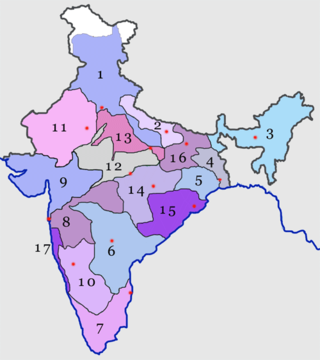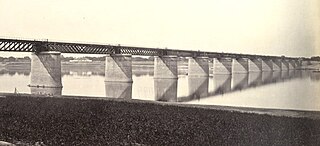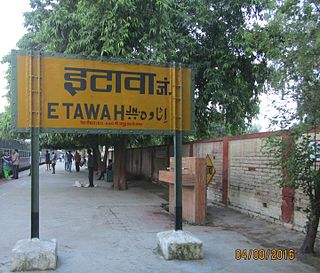
The Northern Railway (NR) is one of the 17 Railway zones of India and the northernmost zone of the Indian Railways. It is headquartered at Baroda House in New Delhi.

The East Central Railway is one of the 19 railway zones in India. It is headquartered at Hajipur and comprises Sonpur, Samastipur, Danapur, Pt. Deen Dayal Upadhyaya, and Dhanbad divisions.

The Runcorn Railway Bridge, Ethelfleda Bridge or Britannia Bridge crosses the River Mersey at Runcorn Gap between Runcorn and Widnes in Cheshire, England. It is alongside the Silver Jubilee Bridge. The bridge is recorded in the National Heritage List for England as a Grade II* Listed building.

The Blue Line is a rapid transit metro line of the Delhi Metro in Delhi, India. Predominantly elevated, it is the longest line on the network and consists of a Main Line(Line 3) with 50 stations from Noida Electronic City to Dwarka Sector 21, spanning a length of 56.11 kilometres, and a Branch Line(Line 4) consisting of 8 stations from Vaishali to Yamuna Bank, with a length of 8.51 kilometres.

Delhi has significant reliance on its transport infrastructure. The city has developed a highly efficient public transport system with the introduction of the Delhi Metro, which is undergoing a rapid modernization and expansion since 2006. There are 16.6 million registered vehicles in the city as of 30 June 2014, which is the highest in the world among all cities, most of which do not follow any pollution emission norm, while the Delhi metropolitan region has 11.2 million vehicles. Delhi and NCR lose nearly 42 crore man-hours every month while commuting between home and office through public transport, due to the traffic congestion. Therefore, serious efforts, including a number of transport infrastructure projects, are under way to encourage usage of public transport in the city.

Delhi Junction railway station, located in Chandni Chowk, Old Delhi, is the oldest railway station in Delhi, India. It is one of the busiest railway stations in the country, with around 250 trains commencing, terminating, or passing through it daily. Established in 1864, it originally served trains arriving from Calcutta.

The East Indian Railway Company, operating as the East Indian Railway, introduced railways to East India and North India, while the Companies such as the Great Indian Peninsula Railway, South Indian Railway, Bombay, Baroda and Central India Railway and the North-Western Railway operated in other parts of India. The company was established on 1 June 1845 in London by a deed of settlement with a capital of £4,000,000, largely raised in London.

The Digha–Sonpur bridge or J. P. Setu is a rail-cum-road steel truss bridge across river Ganga, connecting Digha Ghat in Patna and Pahleja Ghat in Sonpur. It is named after Indian independence activist Jayaprakash Narayan. It provides easy roadway and railway link between north and south Bihar.

The Howrah–New Delhi main line is a railway line connecting Delhi and Kolkata cutting across northern India. The 1,531 km (951 mi) railway line was opened to traffic in 1866 with the introduction of the "1 Down/2 Up Mail" train.

The Sahibganj loop is a railway line connecting Khana Junction and Kiul Junction. Originally a part of the Howrah–Delhi main line, it was opened to traffic in 1866. With the construction of a shorter railway line for a part of the route, the 403.8 kilometres (250.9 mi) stretch was assigned a separate identity.

The Gaya–Pandit Deen Dayal Upadhyaya Junction section, formerly Gaya–Mughalsarai section , is a railway line connecting Gaya Junction and Pandit Deen Dayal Upadhyaya Junction. This 197-kilometre (122 mi) track is part of the Grand Chord, Howrah–Gaya–Delhi line and Howrah–Prayagraj–Mumbai line. This section includes Arrah-Sasaram and Son Nagar branch lines. It is under the jurisdiction of East Central Railway.

The Old Naini Bridge is one of the longest and oldest bridges in India, located in Prayagraj. It is a double-decked steel truss bridge which runs across the Yamuna river in the southern part of the city. The bridge runs north-south across the Yamuna river connecting the city of Prayagraj to the neighbouring area of Naini. Its upper deck has a two lane railway line which connects Naini Junction railway station to Allahabad Junction railway station, while the lower deck has successfully been facilitating roadway services since 1927.

The Pandit Deen Dayal Upadhyaya Junction – Kanpur section, formerly Mughalsarai–Kanpur section, officially Kanpur - Pt. Deen Dayal Upadhyay (CNB-DDU) section, is a railway line connecting Pandit Deen Dayal Upadhyaya Junction (DDU) and Kanpur Central (CNB) stations. This 347 km (216 mi) track is part of the Howrah–Delhi main line and Howrah–Gaya–Delhi line. The main line is under the jurisdiction of North Central Railway. Pandit Deen Dayal Upadhyaya Junction is under the jurisdiction of East Central Railway. Some branch lines are under the jurisdiction of the North Eastern Railway and Northern Railway.

Prayagraj Junction, formerly known as Allahabad Junction, is a railway station on the Howrah-Gaya-Delhi line,Howrah–Delhi main line, Prayagraj–Mau–Gorakhpur main line and Howrah–Prayagraj–Mumbai line. It is the headquarters of the North Central Railway zone. It is located in Prayagraj in the Indian state of Uttar Pradesh. It serves Prayagraj and the surrounding areas.

Fatehpur railway station is on the Pandit Deen Dayal Upadhyaya Junction – Kanpur section of the Howrah–Delhi main line under Prayagraj railway division. It is located in Fatehpur district in the Indian state of Uttar Pradesh. It serves Fatehpur and the surrounding areas.Other major station in the city of fatehpur are Aung, bindki road, kanspur guguali, Malwa, kurasti kalan, Ramva, Faizullapur, Rasulabad, Sath naraini, Khaga railway station.

The Kanpur–Delhi section is a railway line connecting Kanpur Central and Delhi. This section includes Agra Chord and Etah link. The main line is part of Howrah–Delhi main line and Howrah–Gaya–Delhi line. The Agra–Delhi chord is part of Delhi–Mumbai line and Delhi–Chennai line.

Etawah Junction railway station is one of the main railway stations on the Kanpur–Delhi section of Howrah–Delhi main line and Howrah-Gaya-Delhi line.It is 139 km (86 mi) away from Kanpur Central.Tundla is 92 km (57 mi) from here, from where lines to Agra bifurcates. It is located in Etawah district in the Indian state of Uttar Pradesh. It serves Etawah and the surrounding areas. Etawah stands near the confluence of the Yamuna and the Chambal.

Bhagalpur Junction railway station, is an A-1 category railway station serving the city of Bhagalpur in the Bhagalpur district of Indian state of Bihar. It comes under jurisdiction of Malda Railway Division of Eastern Railway Zone of Indian Railways. Bhagalpur Railway Station is among the 148 important stations that have been selected for redevelopment with world-class infrastructure having an airport like look. Ministry of Railways has approved its master plan for redevelopment at a cost of 481.60 crores and tender is in process. A new Bhagalpur station will also be built near the bypass at a cost of 200 crores.

Sadliers Crossing Railway Bridge is a heritage-listed railway bridge at over Bremer River between Tallon Street, Sadliers Crossing and Dixon Street, Wulkuraka, Queensland, Australia on the Main Line (this section is now the Ipswich and Rosewood railway line. It was added to the Queensland Heritage Register on 13 November 2008.

The Signature Bridge is a cantilever spar cable-stayed bridge which spans the Yamuna river at Shourya section, connecting Wazirabad to East Delhi. It is India's first asymmetrical cable-stayed bridge. The pylon of the Signature bridge is the tallest structure in Delhi and is double the height of Qutub Minar with its 154-metre high viewing box, which is a location where visitors take selfies. It shortens the travel time between north and northeast Delhi.




















